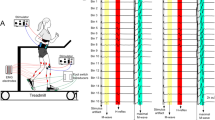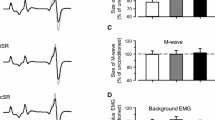Abstract
To investigate the effects of gravity-related somatosensory information on spinal human reflexes, the soleus H-reflex was recorded in ten healthy subjects walking on a treadmill at 2.0 km/h on land and in water. The modulation pattern of the soleus H-reflex was determined in ten different phases of the step cycle. While the subjects were walking in water, the background electromyographic activity (BGA) of the soleus was lower than that on land; on the other hand, the soleus H-reflex amplitude while the subjects were walking in water showed no significant differences throughout the step cycle compared with that while the subjects were on land; the phase-dependent soleus H-reflex modulation pattern was well preserved while walking in water. There was a linear relationship between the BGA and the H-reflex amplitude in each condition; however, the soleus H-reflex gain while walking in water was significantly higher than that on land. These findings suggest that the somatosensory graviception can markedly reduce the spinal reflex excitability. Our findings are discussed in relation to human gait; therefore, further studies are needed to clarify the effect of somatosensory graviception on human neural mechanisms.

Similar content being viewed by others
References
Capaday C, Stein RB (1986) Amplitude modulation of the soleus H-reflex in the human during walking and standing. J Neurosci 6:1308–1313
Capaday C, Stein RB (1987) Difference in the amplitude of the human soleus H reflex during walking and running. J Physiol 392:513–522
Dietz V (1992) Human neuronal control of automatic funtional movements: interaction between central programs and afferent input. Physiol Rev 72:33–69
Dietz V, Duysens J (2000) Significance of load receptor input during locomotion: a review. Gait Posture 11:102–110
Duysens J, Clarac F, Cruse H (2000) Load-regulation mechanisms in gait and posture: comparative aspects. Physiol Rev 80:83–133
Ferris DP, Aagaard P, Simonsen EB, Farley CT, Dyhre-Poulsen P (2001) Soleus H-reflex gain in humans walking and running under simulated reduced gravity. J Physiol 530:167–180
Harkema SJ, Hurley SL, Patel UK, Requejo PS, Dobkin BH, Edgerton VR (1997) Human lumbosacral spinal cord interprets loading during stepping. J Neurophysiol 77:797–811
Ivanenko YP, Grasso R, Macellari V, Lacquaniti F (2002) Control of foot trajectory in human locomotion: role of ground contact forces in simulated reduced gravity. J Neurophysiol 87:3070–3089
Katz R, Meunier S, Pierrot-Deseilligny E (1988) Changes in presynaptic inhibition of Ia fibres in man while standing. Brain 111:417–437
Kawashima N, Sekiguchi H, Miyoshi T, Nakazawa K, Akai M (2003) Inhibition of the human soleus Hoffman reflex during standing without descending commands. Neurosci Lett 345:41–44
Knikou M, Conway BA (2001) Modulation of soleus H-reflex following ipsilateral mechanical loading of the sole of the foot in normal and complete spinal cord injured humans. Neurosci Lett 303:107–110
Koceja DM, Markus CA, Trimble MH (1995) Postural modulation of the soleus H reflex in young and old subjects. Electroencephalogr Clin Neurophysiol 97:387–393
Miyoshi T, Nozaki D, Sekiguchi H, Kimura T, Sato T, Komeda T, Nakazawa K, Yano H (2003) Somatosensory graviception inhibits soleus H-reflex during erect posture in humans as revealed by parabolic flight experiment. Exp Brain Res 150:109–113
Miyoshi T, Shirota T, Yamamoto S-I, Nakazawa K, Akai M (2004) Effect of the walking speed to the lower limb joint angular displacements, joint moments and ground reaction forces during walking in water. Disabil Rehabil 26:724–732
Nakazawa K, Miyoshi T, Sekiguchi H, Nozaki D, Akai M, Yano H (2004) Effects of loading and unloading of lower limb joints on the soleus H-reflex in standing humans. Clin Neurophysiol 115:1296–1304
Schneider C, Lavoie BA, Capaday C (2000) On the origin of the soleus H-reflex modulation pattern during human walking and its task-dependent differences. J Neurophyiol 83:2881–2890
Simonsen EB, Dyhre-Poulsen P (1999) Amplitude of the human soleus H reflex during walking and running. J Physiol 515:929–939
Simonsen EB, Dyhre-Poulsen P, Voigt M (1995) Excitability of the soleus H reflex during graded walking in humans. Acta Physiol Scand 153:21–32
Author information
Authors and Affiliations
Corresponding author
Rights and permissions
About this article
Cite this article
Miyoshi, T., Hotta, K., Yamamoto, SI. et al. Somatosensory graviception inhibits soleus H-reflex gain in humans during walking. Exp Brain Res 169, 135–138 (2006). https://doi.org/10.1007/s00221-005-0289-2
Received:
Accepted:
Published:
Issue Date:
DOI: https://doi.org/10.1007/s00221-005-0289-2




